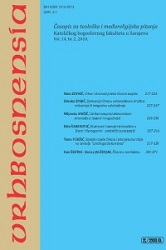Glazbeno oblikovanje misnog ordinarija Sanctusa
Musical Formation of the Sanctus in the Ordinary of Mass
Author(s): Vinka BešlićSubject(s): Music, Biblical studies, History of Art
Published by: Katolički bogoslovni fakultet
Keywords: Sanctus; melody; hymn of praise; song; renewal of the liturgy;
Summary/Abstract: The essential determinants of the history of church music rely on the Jewish liturgy and biblical texts. Singing is thanksgiving, a hymn of praise, the response of the people of God to His glorious works of salvation. Initially, the parts of the Ordinary Mass were sung by the whole community of believers. As time passed, the faithful were less involved since the melodies were more complicated. The response to this has sometimes gone too far and the Sanctus has been replaced by one or other folk song that is known to the people. Over time, especially after the Second Vatican Council, this hymn from the Ordinary Mass was returned to the people of God. Documents, instructions and constitutions of the Teaching of the Church played a significant role. The text of biblical origin, its long tradition of use in the liturgy of the Church, and the theological emphasis of the text, all argue against replacing it with another text. The very nature of the Sanctus as an acclamation and a hymn points to the fact that it is the counterpart of that hymn sung by the angels in heaven and is thus entirely suited to the liturgical celebration. The Sanctus is a hymn of praise and an acclamation. It is therefore necessary to take care when setting it to music that the range of the melody is limited, so that all participants in the liturgical celebration can take part. This requires not only professional musical training, but also professional theological training of the church musicians and the leaders of the church singing.
Journal: Vrhbosnensia
- Issue Year: 2021
- Issue No: 1
- Page Range: 95-106
- Page Count: 12
- Language: Croatian

